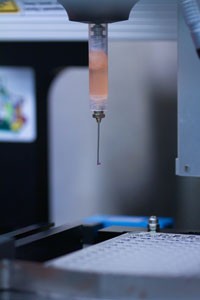Play all audios:
Tissue engineering via additive manufacturing—better known as 3D printing—is leaving the lab and making inroads in commercial applications. San Diego-based Organovo aims to improve both the
_in vitro_ testing pipeline as well as transplant prospects with the help of 3D printing. Founded in late 2007, the company licensed their bioprinting technology from the University of
Missouri, where it was developed in the lab of scientific co-founder Gabor Forgacs. According to Eric Michael David, M.D., J.D., chief strategy officer and executive vice president of
preclinical development, Organovo's technology uses three different methods of deposition—droplet-based, inkjet, and continuous—to create finished tissues printed from human cells that
are close to 100% cellular, eliminating exogenous scaffolds and plastic culture dishes that can disrupt normal behavior. These tissues are, David claims, “about as close as you can get to
testing on a human being before actually entering human trials.” He still considers traditional cell cultures useful for initial high-throughput screenings, but believes Organovo's
tissues are valuable for more in depth _in vitro_ work. The tissues may also help refine the use of laboratory animals, offering an alternative where animal models do not sufficiently
recapitulate a human condition or reveal contradictory results. Facilitating drug discovery is one thing, but printing viable, biocompatible tissues that can be transplanted into a human
patient is a greater challenge. The ultimate goal may one day be a fully functional organ, but in the meantime Organovo is pursuing the potency of smaller tissue grafts. David comments, “We
really hope to be able to make smaller pieces of tissue over the next several years that can be implanted into the body and at the very least bridge patients a few more years before they
need a transplant...Eventually yes, we do hope to be able to create much larger pieces of tissue and even entire organs, but there's a pathway to that by first creating these smaller
tissues.” At the annual TERMIS-Americas meeting in December 2016, the company presented the results of a proof-of-concept study where they engrafted a liver patch printed from human
hepatocytes and select nonparenchymal cells onto the livers of NOD-SCID mice. They observed stable engraftment over several weeks and detected human albumin, alpha-1-antitrypsin, and
fibrinogen proteins circulating through the murine blood streams, indicating that the liver patch is a viable product for further research in animal models. Credit: Courtesy of Organovo The
company is looking to target two orphan indications that tend to culminate in the need for a liver transplant: pediatric inborn errors of metabolism that disrupt liver function, and
acute-on-chronic liver failure, in which patients with an otherwise manageable chronic condition are pushed towards failure by an acute event such as an infection or bad drug interaction.
The next step is testing their tissue in an animal model of liver disease for FDA approval to move into clinical trials. Previous clinical trials attempting to infuse hepatocytes directly
into the hepatic portal vein were unsuccessful, and limited, David suggests, by the inability of cell infusions to remain in the liver and engraft or vascularize. Based on early data, he is
hopeful that Organovo's 3D-printed tissues will remain at the patient's liver and be able to effectively engraft, potentially providing therapeutic benefits. Whether or not
Organovo's 3D-printed tissue transplants prove successful as they move through the approval pipeline, the FDA is anticipating an increase in applications that involve the technology. In
March 2016, they approved the first bioprinted drug, SPRITAM, an epilepsy medication manufactured by Aprecia; they have also approved over 85 applications for 3D-printed devices. Bioprinted
cells and tissues, however, are newer territory. The agency is preparing guidance and working with academic and industry researchers to better understand the technology and the advances
that may soon be just a printer away. Authors * Ellen P. Neff View author publications You can also search for this author inPubMed Google Scholar RIGHTS AND PERMISSIONS Reprints and
permissions ABOUT THIS ARTICLE CITE THIS ARTICLE Neff, E. Printing cures: Organovo advances with 3D-printed liver tissue. _Lab Anim_ 46, 57 (2017). https://doi.org/10.1038/laban.1203
Download citation * Published: 17 February 2017 * Issue Date: March 2017 * DOI: https://doi.org/10.1038/laban.1203 SHARE THIS ARTICLE Anyone you share the following link with will be able to
read this content: Get shareable link Sorry, a shareable link is not currently available for this article. Copy to clipboard Provided by the Springer Nature SharedIt content-sharing
initiative

